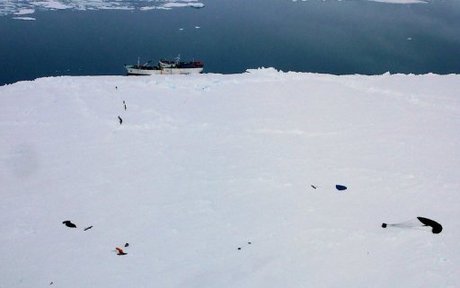Study Shows Man Partly to Blame for Antarctic Ice Shelf Collapse

An ice core extracted from an Antarctic islet has yielded further evidence of the impact of man-made warming on the frozen continent, fuelling concern for the future of ice shelves, a report said Wednesday.
The 364-meter ice core drilled from James Ross Island on the Antarctic peninsula has been studied in laboratories in Europe for the past four years, for its 15,000-year record of snowfalls holds clues about climate shift.
The peninsula -- the tentacle of Antarctica that projects towards South America -- is a keen area of interest for climatologists, given that it has warmed faster than almost anywhere else in the world.
The core shows that after several centuries of cooling, temperatures in the region began climbing slowly around 600 years ago, rising at a rate of about 0.2 degrees Celsius (0.36 degrees Fahrenheit) per century.
The warming increased exponentially, reaching an unusually high, though not unprecedented, rate during the last 100 years of about 1.5 C (2.7 F), the report published in Nature said.
The results "are consistent with a more rapid human-induced warming on top of a slower natural warming," Robert Mulvaney, a researcher with the British Antarctic Survey (BAS), told Agence France Presse.
Meteorological stations have shown a rise of 2 C (3.6 F) in the past 50 years in the Antarctic peninsula, which is roughly triple that of the global temperature rise.
"If the warming continues, then ice shelves further south in the peninsula that are believed to have been stable since the last ice age may also break up in the next few decades," Mulvaney warned.
Ice shelves are floating mats of ice, attached to the Antarctic coast, that are formed by flowing glaciers. In recent years, several major ice shelves have broken away from the peninsula, a result of what scientists say is an upwelling of warmer water from the Southern Ocean.
Reporting on climate change in another threatened region, also in Nature, scientists said that the picture in the Himalayan mountain range may be more nuanced than previously thought.
In what they claimed was the first measure of glacier thickness changes over the entire 2,000-kilometer range, a team of scientists from Norway and France said southern glaciers were melting while those in the north seem to be unchanged or even gaining mass.
The Himalayan glaciers, rivers of ice fed by snow and flowing between mountains, provide water for people living along rivers but also contribute to potentially dangerous sea level rise.
Scientists have been at odds for years over whether the Himalayan glaciers are shrinking or not.
The latest study used a novel method of sending laser pulses from a NASA satellite to Earth, and measuring over a six-year period from 2003 how long it takes for these to return to base.
In the southern ranges including Nepal and Bhutan, the distance the pulses travelled became longer and longer, meaning the glaciers were becoming thinner.
But over the northern Karakoram, the distance remained the same or even became shorter, researcher Andreas Kaab of the University of Oslo explained.



